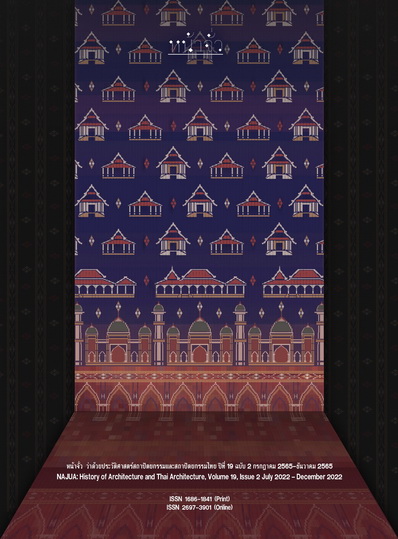Forgotten Heritage: Ancient Royal Gardens in Southeast Asia
Main Article Content
Abstract
Ancient royal gardens are considered as historic gardens—one of the oldest cultural heritages of mankind. They maintained high level of artistic and design value and reflected human attitudes towards nature in past eras. These gardens represented symbols of sovereignty and the life at royal court.
The study on historic gardens in Southeast Asia is extremely limited and has not been received as much attention from scholars as the study of architecture. Previous studies described historic gardens of this region in a broader sense, and it was generally assumed that historic gardens in Southeast Asia do not have specific design patterns.
This article is a first attempt at listing and analyzing ancient royal gardens in Southeast Asia, focusing on the period from the eighth to early twentieth centuries for which social and cultural development influenced the design of gardens. The expected results of this research can provide the database for further studies on garden tourism as well as the conservation and management policies for ancient royal gardens in Southeast Asia.
There are two criteria for selecting royal gardens. First, a garden had to be in continuous usage to the present day or contain archaeological remains of certain garden features. Second, a garden had to be at least 50 years old. To compile the preliminary list of ancient royal gardens, this research relied on a vast pool of secondary sources which are related to history, culture, archeology, art, and architecture. Following the creation of the list, field surveys, archival research, and interviews with local scholars were also conducted.
There are twenty-seven ancient royal gardens on a final complied list. Found in Thailand, Indonesia, Vietnam, Myanmar and Cambodia, the ancient royal gardens can be classified into three types: royal palace gardens, summer palace gardens, and royal tomb gardens. It can be clearly seen that external influences such as South Asian, Chinese, and European cultures played an important role in the development of design and concept of ancient royal gardens. Although, stylistic and formal analysis reveals some shared garden features and design, ancient royal gardens in Southeast Asia are indeed complex. They exhibit varied garden arts and the adaptation to local environments and cultures.
Downloads
Article Details

This work is licensed under a Creative Commons Attribution-NonCommercial-NoDerivatives 4.0 International License.
References
Boomgaard, Peter. “The high sanctuary; Local perceptions of mountains in Indonesia, 1750-2000.” In Framing Indonesian realities; Essays in symbolic anthropology in honour of Reimar Schefold, 295-313. Leiden: KITLV Press, 2003.
Chihara, Daigoro. “Hindu-Buddhist Architecture in Southeast Asia.” In Studies in Asian Art and Archaeology volume 19. Leiden: Brill, 1996.
Christie, Jan Wisseman. “Water and rice in early Java and Bali.” In A world of water: Rain, rivers and seas in Southeast Asian histories, 235-258. Edited by Peter Boomgaard. Singapore: NUS Press, 2007.
Dumarcay, Jacques. The Palaces of Southeast Asia. Kuala Lumpur: Oxford University Press, 1991.
Feliú, Carmen Añón. “The Theory.” In Historic gardens: Safeguarding a European heritage, 31-44. Luxembourg: Office for Official Publications of the E.C., 1996.
Gothein, Marie-Luise. Indian gardens: History and design. Noted by Tom Turner London: Gardenvisit.com, 2008.
Heyer, Hans-Rudolf. “Shifting meanings in a garden landscape.” In Preservation, restoration of historic gardens, landscapes, 240-247. Washington D.C.: Dumbarton Oaks Research Library and Collections, 1976.
Historic Scotland and Scottish Natural Heritage. An inventory of gardens and designed landscapes, supplementary volume 2 highlands & islands. Edinburgh: Historic Scotland, Scottish Natural Heritage, 1987.
Pregill, Phil and Nancy Volkman. Landscapes in history: Design and planning in the western tradition. New York: Van Nostrand Reinhold, 1999.
Scottish Development Dept Land Use Consultants (Great Britain). A study of gardens and designed landscapes in Scotland. Edinburgh: Countryside Commission for Scotland, 1983.
Silva, Nimal De. Landscape tradition of Sri Lanka: Philosophy, principles, and practices. Colombo: Deveco Designers & Publishers, 1996.
Singh, Priyaleen. Historic gardens: making an inventory for the Indian context. New Delhi: Intach, 2006.
Stryker, Kimberly. “The gardens of Hue: Window onto traditional Vietnam.” In The king's crown: Essays on XVIIIth and XIXth century literature, art, and history honoring Basil J. Guy, 153-165. Edited by Francis Assaf. Leuven: Peeters Publishers, 2005.
Turner, Tom. Asian gardens: History, beliefs and design. London: Routledge, 2010.


